COVID-19 and Construction Sites: What You Need to Know
The obvious and not-so-obvious costs of the COVID-19 pandemic
Introduction
It goes without saying that the current pandemic, and the resulting public and private policies that were enacted to deal with it, has disrupted and transformed every aspect of work in the past two years. As workplaces shuttered, production slowed, and workforces struggled to cope with new realities and mandates, no industry was left untouched by the pandemic. The construction industry was no exception to these challenges; a study completed in October of 2020 found that construction had the highest rate of infection out of all industries surveyed. To this day, construction companies are still coping to adapt to the post-COVID world and all of its ramifications.
Nowhere is this new reality more evident than at the level of the construction project site. The individual site is the locus of all physical labor, and thus the most vulnerable to infection outbreaks, production shutdowns, labor shortages, mitigation procedures and costs, and scrutiny from regulatory agencies.
Nowhere is this new reality more evident than at the level of the construction project site. The individual site is the locus of all physical labor, and thus the most vulnerable to infection outbreaks, production shutdowns, labor shortages, mitigation procedures and costs, and scrutiny from regulatory agencies.
Shutting down and dropping out
As the COVID-19 virus spreads throughout the labor force, many workers are forced into staying at home, either by becoming sick themselves or needing to quarantine after contact with the infected. An industrial scale contractor who is importing laborers or specialized technicians from abroad will have to endure the delay of 2-week quarantines for their international personnel. The fallout from quarantined workers means that sites have to grapple with smaller workforces, greater workloads per worker, decreasing productivity across the board, and ultimately mounting project delays and change orders. As the infection peaks come in waves, groups of laborers periodically have to drop out of work on a rolling basis.
With the threat of an outbreak looming, an owner may decide to completely shut down a project, motivated by concern for safety or fears of liability. In the event that an owner decides to persist through an outbreak, it is still possible that local government edicts can force site production to shut down. With a pandemic dragging on for years, publicly managed by unpredictable political decision makers, an owner may be looking at several site shutdowns over time. General contractors in this situation will see their current projects and backlog evaporate, hampering their ability to pay both staff and vendors, while early returns for equipment results in financial penalties. Several halts and starts back into production make financial planning even more difficult, as a shifting backlog starts to make financial projections murkier and harder to map out. Shutting and opening sites also results in a broken operational tempo, as both laborers and managers require time to ramp back up to full productivity after each break.
With the threat of an outbreak looming, an owner may decide to completely shut down a project, motivated by concern for safety or fears of liability. In the event that an owner decides to persist through an outbreak, it is still possible that local government edicts can force site production to shut down. With a pandemic dragging on for years, publicly managed by unpredictable political decision makers, an owner may be looking at several site shutdowns over time. General contractors in this situation will see their current projects and backlog evaporate, hampering their ability to pay both staff and vendors, while early returns for equipment results in financial penalties. Several halts and starts back into production make financial planning even more difficult, as a shifting backlog starts to make financial projections murkier and harder to map out. Shutting and opening sites also results in a broken operational tempo, as both laborers and managers require time to ramp back up to full productivity after each break.
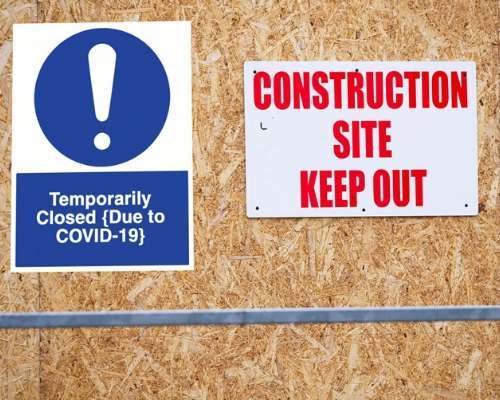
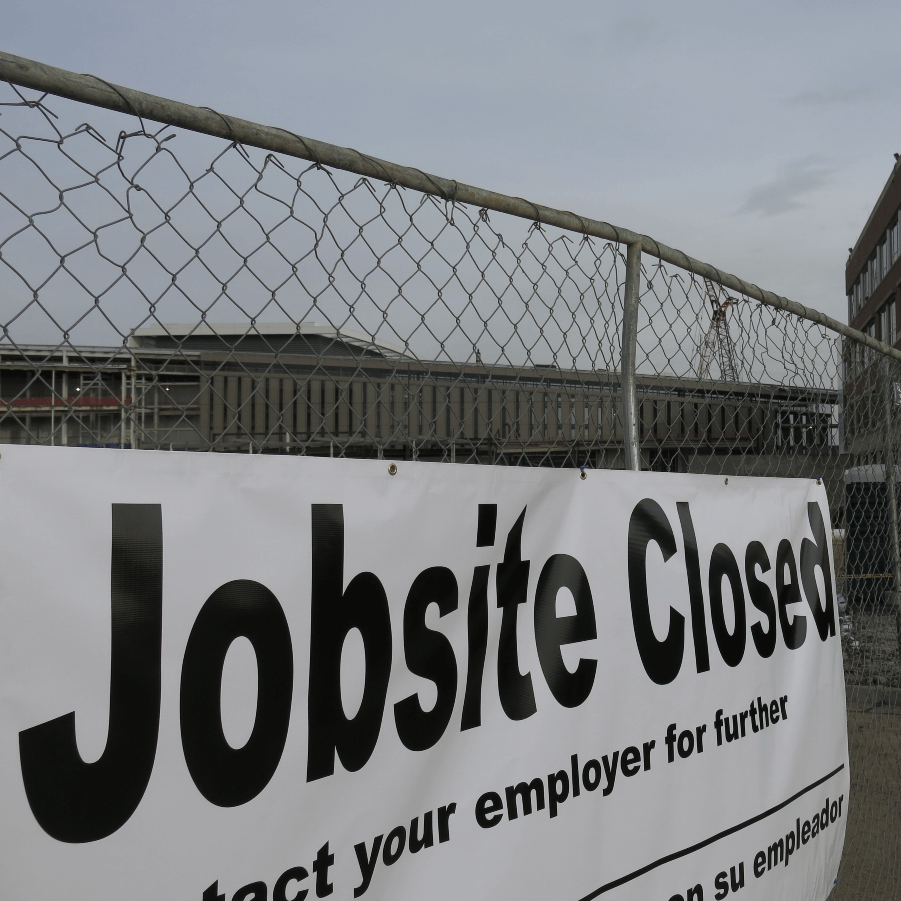
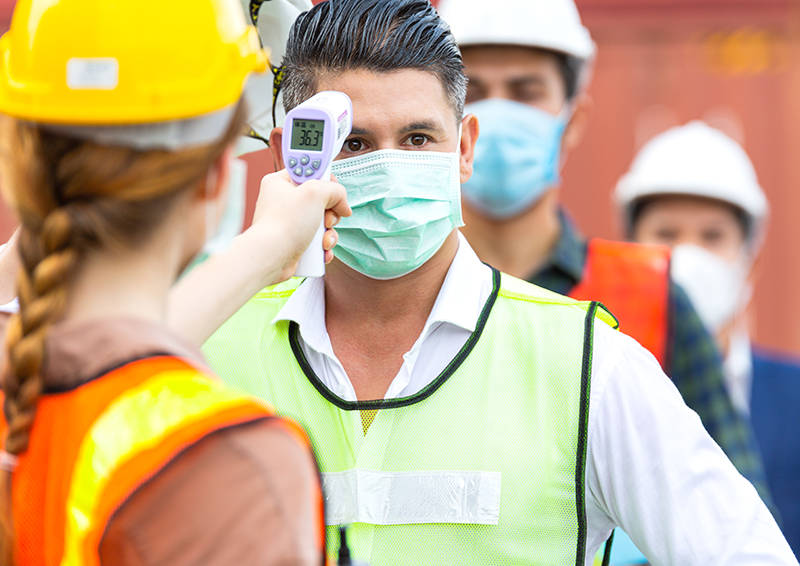
Back to work
In order to ensure that uninfected workers can access the site, compliance check staff and protocols are to be put into place. This means dedicated workers to control access, administer rapid tests, perform temperature checks, and receive paperwork regarding vaccination status, test statuses, questionnaires and waivers. In addition, this creates greater workloads for HR staff as they have to implement, organize, and maintain all new compliance data. New staff are hired, or existing staff retrained, to maintain safe access to the grounds.
Once coping with the reality of a pandemic on the construction site, an owner then decides on how to implement OSHA, CDC, state and local COVID-19 guidelines (or may be forced to by governing bodies). This includes such protocols as a six-foot physical distancing rule between workers, the use of physical barriers between workers in indoor environments, adopting staggered shifts or maximum personnel on site rules, wearing highly rated PPE, personal hygiene practices, surface sanitizing, decontamination or disposal of PPE, preventing shared use of objects, and screening all visitors to the job site.
Maximum worker rules or staggered shifts obviously reduce labor capacity at the macro scale, while social distancing guidelines on busy sites slow down productivity, as workers have to negotiate the obstacle of each other’s personal space. Cleaning and sanitizing protocols necessitate either new dedicated cleaning staff, or more time and training from existing laborers. The observance of PPE rules causes workers to need more cool-off breaks, and extra procedures around hygiene, decontamination, disposal, and sharing of tools require extra time. When the aggregate effect of all these activities is felt, it becomes quite clear that COVID-19 safety protocols constitute a sizeable drag on site productivity and time away from project goals.
In addition to dealing with the cost of extra staff and lowered productivity, GCs also have to spend money on ordering mass quantities of PPE, expanding on-site temp office spaces and lunch rooms for social distancing, and adding ventilation infrastructure and hand washing stations. Major industrial construction companies typically bear a much greater portion of indirect costs on projects; owner organizations that are especially cautious of COVID-19 outbreaks endure ballooning indirect expenses at scale to manage the challenge.
Once coping with the reality of a pandemic on the construction site, an owner then decides on how to implement OSHA, CDC, state and local COVID-19 guidelines (or may be forced to by governing bodies). This includes such protocols as a six-foot physical distancing rule between workers, the use of physical barriers between workers in indoor environments, adopting staggered shifts or maximum personnel on site rules, wearing highly rated PPE, personal hygiene practices, surface sanitizing, decontamination or disposal of PPE, preventing shared use of objects, and screening all visitors to the job site.
Maximum worker rules or staggered shifts obviously reduce labor capacity at the macro scale, while social distancing guidelines on busy sites slow down productivity, as workers have to negotiate the obstacle of each other’s personal space. Cleaning and sanitizing protocols necessitate either new dedicated cleaning staff, or more time and training from existing laborers. The observance of PPE rules causes workers to need more cool-off breaks, and extra procedures around hygiene, decontamination, disposal, and sharing of tools require extra time. When the aggregate effect of all these activities is felt, it becomes quite clear that COVID-19 safety protocols constitute a sizeable drag on site productivity and time away from project goals.
In addition to dealing with the cost of extra staff and lowered productivity, GCs also have to spend money on ordering mass quantities of PPE, expanding on-site temp office spaces and lunch rooms for social distancing, and adding ventilation infrastructure and hand washing stations. Major industrial construction companies typically bear a much greater portion of indirect costs on projects; owner organizations that are especially cautious of COVID-19 outbreaks endure ballooning indirect expenses at scale to manage the challenge.
Death by a thousand cuts
Indirect cost burdens don’t stop there, either. Project delays can carry additional expenses of more time for equipment and establishment facilities to remain on site. OSHA requires fewer people per vehicle than before, necessitating the use of more vehicles and thus more outlays for maintenance, insurance and fuel. Delays also often involve penalties or extended coverage requirements with workplace insurance carriers. Due to pandemic conditions, many insurance carriers have increased premiums and stiffened their guidelines. And as projects fail to be completed on time, contractors may subject to damage claims from clients or other obligees.
General contractors who are deemed to be in defiance COVID-19 related rules and regulations can be subject to onerous fines by city, state and federal regulatory bodies. Workplace outbreaks, especially ones that result in deaths, can bring harsh OSHA fines and penalties. While the federal emergency mandate to require vaccination at large companies was recently struck down by the supreme court, certain local and state governments can still levy fines for on-site, unvaccinated workers.
Labor shortages, in addition to reducing work capacity, have the effect of increasing wages and compensation for remaining workers. Construction firms everywhere are also hit by the downstream effects of supply chain delays and the resulting rise in the cost of materials. While these effects are more a condition of the general economic environment, they still add to the increasing burden of overheads imposed on contractors, owners and clients.
A picture should be emerging that the possibility of outbreak in the construction workforce has innumerable financial impacts; some of those impacts are direct, while others have further downstream costs. Reduced construction workforce, private and public induced shutdowns, project delays, impacted planning, inefficient safety protocols, the expense of added facilities and ancillary staff, various contract penalties, and fines from government agencies- any combination of these factors may become an oppressive burden for a contractor’s bottom line. Thankfully, there is a solution that can drastically cut down on the conditions that allow for these expenses to add up.
General contractors who are deemed to be in defiance COVID-19 related rules and regulations can be subject to onerous fines by city, state and federal regulatory bodies. Workplace outbreaks, especially ones that result in deaths, can bring harsh OSHA fines and penalties. While the federal emergency mandate to require vaccination at large companies was recently struck down by the supreme court, certain local and state governments can still levy fines for on-site, unvaccinated workers.
Labor shortages, in addition to reducing work capacity, have the effect of increasing wages and compensation for remaining workers. Construction firms everywhere are also hit by the downstream effects of supply chain delays and the resulting rise in the cost of materials. While these effects are more a condition of the general economic environment, they still add to the increasing burden of overheads imposed on contractors, owners and clients.
A picture should be emerging that the possibility of outbreak in the construction workforce has innumerable financial impacts; some of those impacts are direct, while others have further downstream costs. Reduced construction workforce, private and public induced shutdowns, project delays, impacted planning, inefficient safety protocols, the expense of added facilities and ancillary staff, various contract penalties, and fines from government agencies- any combination of these factors may become an oppressive burden for a contractor’s bottom line. Thankfully, there is a solution that can drastically cut down on the conditions that allow for these expenses to add up.
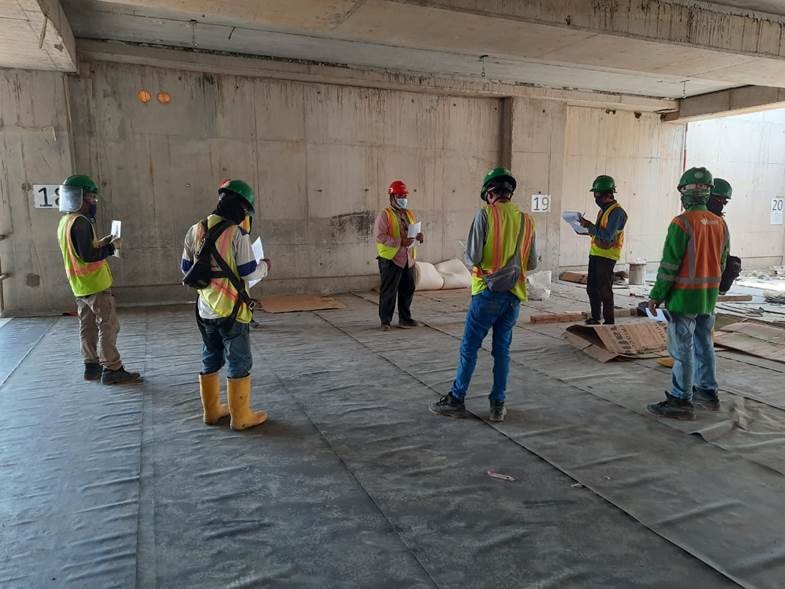
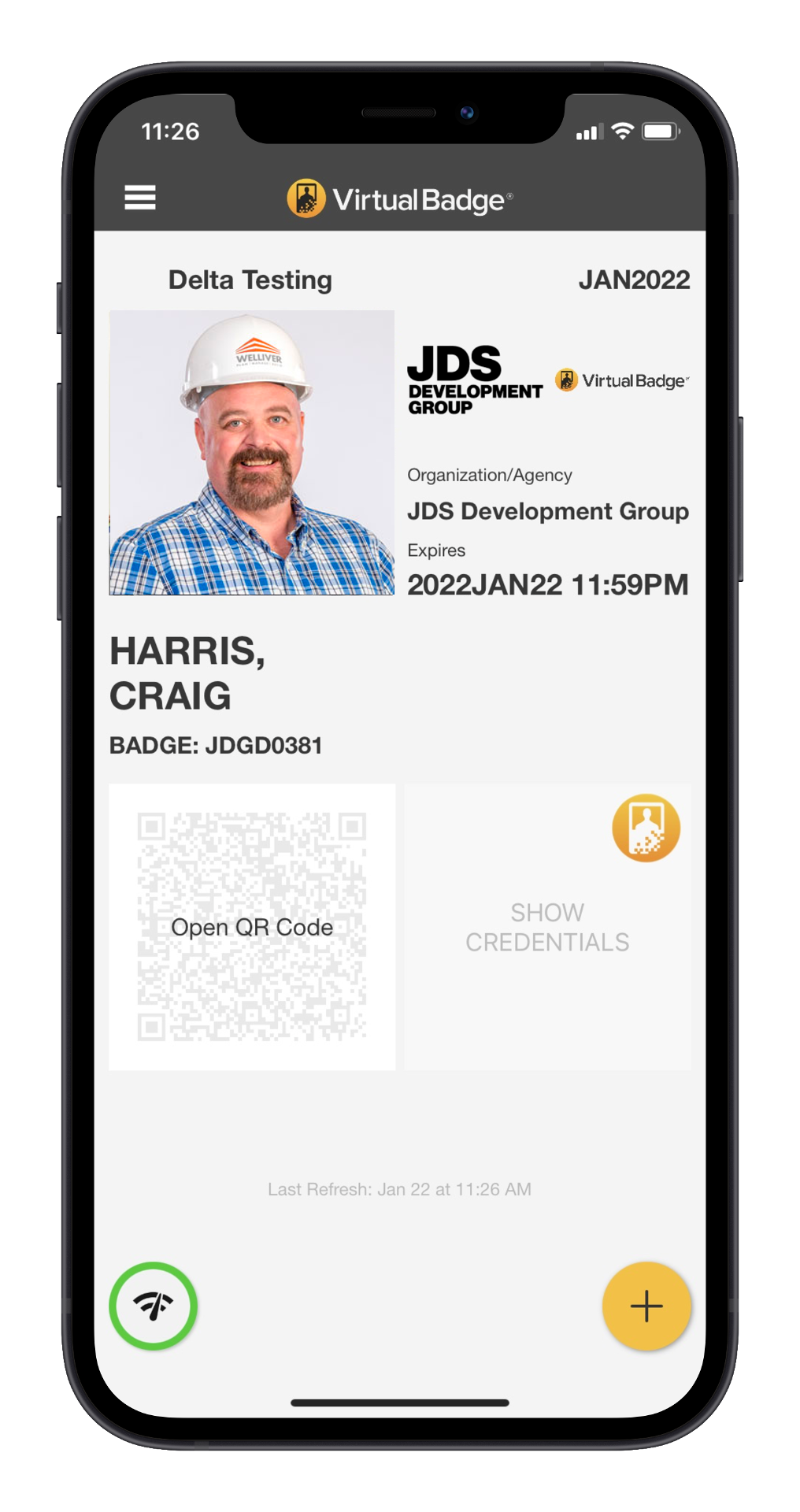
Rooting out the conditions for cost overruns
Virtual badges are a way to provide digital proof of COVID-19 vaccination status and test results for employees, contractors, vendors and customers. By having site visitors remotely upload status of vaccination, rapid test results, or symptom self-report waivers, managers can approve or disapprove badges (and thus site access) before workers even come onto the premises. Virtual badges also drastically simplify the on-site access control process into a simple scan, reducing the need for compliance staff while increasing the ease of following protocols. Managers can easily tell, at a glance, the COVID-19 status of every person on site. For companies that have an insufficient process in place, implementing virtual badges is a risk management blessing.
As an entire health access control system, virtual badges shield construction firms from the legal risk and liability of allowing site access to infected persons; negligence cannot be assigned to the company and compliance is maintained at all levels of government oversight. Even more, they protect the company from the reputational risk of being unsafe. And by drastically reducing the likelihood of an outbreak among staff and contractors, digital badges cut down on the number of staff who end up infected, reducing project delays, change orders and budget overruns.
By centralizing and organizing all of the health data, the burden on HR workers is drastically reduced, and proof of vaccination or negative test is easily available for government regulatory agencies to review. By having a completely vaccine/PCR negative compliant workforce, many firms are allowed to relax their PPE, distancing, worker maximum and cleaning guidelines, allowing for a general rise in productivity.
In the event that a worker is suspected of being sick at the project site, virtual badges support contact tracing capabilities. By tracking the user’s time on site, subcontractor company and geographic zone, managers can quickly determine which other workers came into contact with the infected individual. Messages can then be sent to user badges, warning adjacent individuals to leave and quarantine, and notifying all other workers about the suspected outbreak. Badges belonging to infected or adjacent workers can be remotely deactivated, and kept deactivated until a negative PCR test is produced.
While the COVID-19 pandemic rages on outside of the construction site, there’s no reason for it to spread to the inside. With a virtual badging solution in place, construction firms can feel confident that their workplace is bio-secure, their sites can remain open, and their workforce can stay resilient. Digital ID systems can keep owners free of legal liability and punitive measures, eliminate pandemic-related productivity drag, and keep costs down in an era that sees them ballooning across every metric.
If staying open, on schedule and within budget is a priority for your firm, our experts are available to help you implement the solution, today.
As an entire health access control system, virtual badges shield construction firms from the legal risk and liability of allowing site access to infected persons; negligence cannot be assigned to the company and compliance is maintained at all levels of government oversight. Even more, they protect the company from the reputational risk of being unsafe. And by drastically reducing the likelihood of an outbreak among staff and contractors, digital badges cut down on the number of staff who end up infected, reducing project delays, change orders and budget overruns.
By centralizing and organizing all of the health data, the burden on HR workers is drastically reduced, and proof of vaccination or negative test is easily available for government regulatory agencies to review. By having a completely vaccine/PCR negative compliant workforce, many firms are allowed to relax their PPE, distancing, worker maximum and cleaning guidelines, allowing for a general rise in productivity.
In the event that a worker is suspected of being sick at the project site, virtual badges support contact tracing capabilities. By tracking the user’s time on site, subcontractor company and geographic zone, managers can quickly determine which other workers came into contact with the infected individual. Messages can then be sent to user badges, warning adjacent individuals to leave and quarantine, and notifying all other workers about the suspected outbreak. Badges belonging to infected or adjacent workers can be remotely deactivated, and kept deactivated until a negative PCR test is produced.
While the COVID-19 pandemic rages on outside of the construction site, there’s no reason for it to spread to the inside. With a virtual badging solution in place, construction firms can feel confident that their workplace is bio-secure, their sites can remain open, and their workforce can stay resilient. Digital ID systems can keep owners free of legal liability and punitive measures, eliminate pandemic-related productivity drag, and keep costs down in an era that sees them ballooning across every metric.
If staying open, on schedule and within budget is a priority for your firm, our experts are available to help you implement the solution, today.
